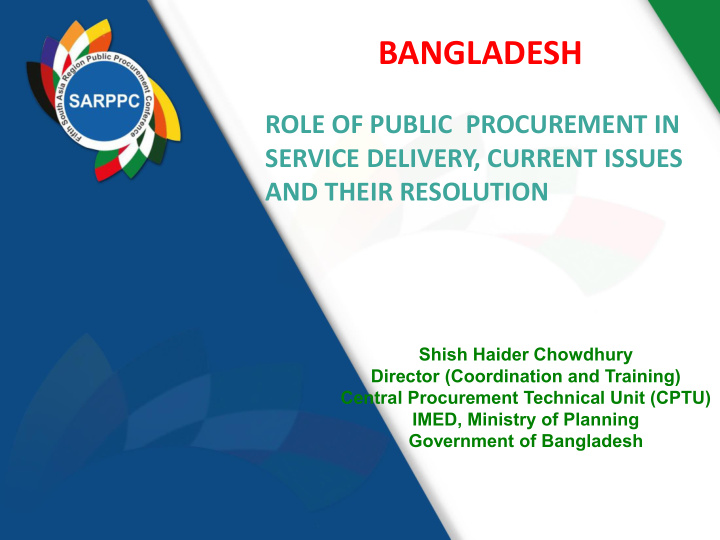



BANGLADESH ROLE OF PUBLIC PROCUREMENT IN SERVICE DELIVERY, CURRENT ISSUES AND THEIR RESOLUTION Shish Haider Chowdhury Director (Coordination and Training) Central Procurement Technical Unit (CPTU) IMED, Ministry of Planning Government of Bangladesh 1
Content 01 Public Procurement and Service Delivery- This is a sample text. Recent Activities & Achievements Insert your desired text here. 02 Sample text Issues, Challenges, Solutions This is a sample text. Insert your desired text here. 03 Sample text Way Forward 04 Action Plan – short term and long term 2
Public Procurement and Service Delivery- Recent Activities & Achievements Public Procurement Act 2006 & PPR 2008 operationalized Capacity of PEs and Tenderers enhanced under PPRP-II e-GP introduced, awareness and dialogue going on Citizen engagement piloted PPRP-II ended 30 June 2017 Digitizing Implementation Monitoring And Public Procurement Project (DIMAPPP) Started 3
Public Procurement and Service Delivery- Recent Activities & Achievements Implementation Registered of e-GP Tenderers 40,745 December, 2017 Tender Total Awards Tender Value: 80,431 79434 4
Issues, Challenges, Solutions Maintaining continuity of reform implementation Making e-procurement sustainable Disposal policy and life cycle cost analysis Submission of abnormally low bids Implementation of e-contract management 5
How to deal with Abnormally Low Bids (ALB) The stages to treatment of an ALB: 1. Identify: the PE identifies a potential ALB based on comparison with available prices from the market, or with the cost estimate; 2. Clarify: the PE seeks clarification from the Bidder/proposer; 3. Justify: the Bidder prepares a justification of their price based on the request from the PE; 4. Verify: the PE fully a�alyzes the Bidder’s justification to verify if it is an ALB; and 5. Decide: the PE fully documents the decision to accept or reject the Bid (with the no-objection of DP, if required). 6
Incoterms used in Public Procurement • CFR: �Cost a�d Freight� �ea�s that the seller delivers when the goods pass the ship's rail in the port of shipment. Seller must pay the costs & freight necessary to bring the goods to the named port of destination, BUT the risk of loss or damage, as well as any additional costs due to events occurring after the time of delivery are transferred from seller to buyer. Seller must clear goods for export. This term can only be used for ocean transport; • CIF: �Cost, I�sura�ce a�d Freight� �ea�s that the seller delivers when the goods pass the ship's rail in the port of shipment. Seller must pay the cost & freight necessary to bring goods to named port of destination. Risk of loss & damage same as CFR. Seller also has to procure marine insurance against buyer's risk of loss/damage during the carriage. Seller must clear the goods for export. This term can only be used for ocean transport; • CIP: �Carriage a�d I�sura�ce Paid to� �ea�s that the seller delivers the goods to the carrier or another person nominated by the seller at an agreed place (if any such place is agreed between parties) and that the seller must contract for and pay the costs of carriage necessary to bring the goods to the named place of destination. 7
Domestic Preference PPR 2008 spells out very clearly about the domestic preferences: In case of procurement of goods its not exceeding 15% of the delivered price; [Rule 83(1)(e)]; In case of works its not exceeding 7.5%; [Rule 98(21)(e)]; In case of service procurement, for international bidding, the PE may assign some point of technical score (e.g. 5-10) taking into account type of services. 8
Contract Management • It is a challenge in case of public procurement of Bangladesh. PPA 2006 and PPR 2008 is very clear and specific up to contract award. But is not that specific about the contract management issue. CPTU is working on it to bring the issue in the PPR. • Grievance redressal mechanism is there. There are two levels namely: Administrative level and the Review Panel level. Once the administrative level fail to address properly the complaints of the Tenderer, the review panel a quasi-judicial body is in existence. Even if they fail, the law of the land is there to address the grievances so unresolved . 9
Action Plan – short term and long term Restructuring CPTU and Furthering Policy 1 Reform Institutionalizing e-GP Expansion of e-GP system 2 Implementation of Contract Management 10
Action Plan – short term and long term • Professionalization of Procurement & Citizen engagement ⁃ Professionalizing procurement with greater institutionalization ⁃ Developing and implementing an accreditation program with different tiers of professional certification 3 • Tier-1: Public Procurement Associate • Tier-2: Public Procurement Professional • Tier-3: Advanced Public Procurement Professional • Tier-4: Fellow Public Procurement Professional 11
Action Plan – short term and long term Public Procurement Training: ⁻ introductory to public procurement - online training [online video tutorial]; ⁻ basic procurement training; ⁻ specialized procurement training; 4 ⁻ highly specialized procurement training; ⁻ procurement management training; and ⁻ short term procurement training. 12
Action Plan – short term and long term To achieve greater Opening of procurement transparency monitoring by data as per RTI law through citizens in about 50 upazila is a Citizen Portal at CPTU planned To maintain momentum in awareness and stakeholders engagement, strategic 5 communication program planned Social media campaign, engagement of beneficiary groups, education program, awareness campaign, Government- Tenderers Forum. 13
14
Recommend
More recommend